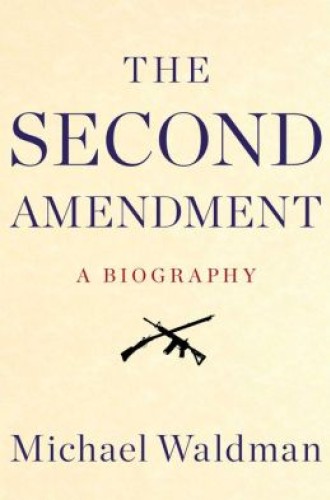The road to Heller
Michael Waldman traces the Second Amendment's life, from militias to the NRA to the newfound right to have handguns at home.
The 2012 shootings at Sandy Hook Elementary School in Newtown, Connecticut, in which Adam Lanza used a semiautomatic rifle to kill 26 people, including 20 children, instantly reignited a debate over gun control. Within hours, an online petition was generated through the White House’s We the People platform demanding that the Obama administration “immediately address the issue of gun control through the introduction of legislation in Congress.”
At the same time, gun sales spiked across the country. The National Rifle Association held a press conference a week after the incident at which its executive vice president, Wayne LaPierre, declared that “the only thing that stops a bad guy with a gun is a good guy with a gun,” and he urged Congress to direct its attention away from gun control laws and toward putting armed police officers into every school. “Politicians,” LaPierre insisted, “have no business and no authority denying us the right, the ability, and the moral imperative to protect ourselves and our loved ones from harm.” He did not invoke the Second Amendment as the source of this “right,” but he didn’t have to. The Second Amendment and its reference to the “right to bear arms” have, through the efforts of the NRA, become intimately associated with opposition to gun regulations.
Read our latest issue or browse back issues.
In the midst of this debate, Michael Waldman, president of the Brennan Center for Justice at New York University’s School of Law, has closely examined the historical context in which the Constitution and the Bill of Rights were drafted and ratified. He convincingly argues that the Second Amendment does not address or protect an individual right to own guns. Its purpose, instead, was to preserve state militias and assuage public concern that the newly established federal government would disarm them. In that era, the citizen-soldier stood as a powerful symbol of state sovereignty, and the survival of the militia system in the new government was viewed by many as an essential safeguard against oppression of the states by a federal standing army.
In practice, however, militia were often poorly trained, disorganized, and unreliable. The militia system faded into irrelevancy shortly after the passage of the Bill of Rights. (The militia ideal has to a limited extent been refashioned into the National Guard.) The Second Amendment received little attention: gun control was left to the states, as it had always been. On the few occasions when the Second Amendment was invoked by the Supreme Court, it consistently held that it protected an individual right to keep and bear arms only within the context of militia service.
All that changed in 2008, when the Supreme Court announced, in District of Columbia v. Heller, that the Second Amendment protects the right of private citizens to keep handguns in their homes for self-protection. Waldman argues that this seemingly abrupt about-face in constitutional jurisprudence, overturning more than 200 years of settled precedent, was the result of “one of history’s most effective, if misleading, campaigns for constitutional change,” a movement led by the NRA and its political allies.
Waldman traces the “road to Heller” back to the radicalization of the NRA in the late 1970s. The organization’s “lurch to the right” was part of a larger conservative backlash against progressive reforms of the 1960s. It was then that the NRA first began to invoke the Second Amendment in vigorously opposing gun restrictions. Once primarily devoted to hunting, sport shooting, and gun safety, the NRA became a soldier on the front lines of the culture wars. Its rhetoric increasingly centered on concepts of individual entitlement, freedom, and revolution. Indeed, it adopted the language of social reform movements while tapping into the public’s growing wariness and resentment of big government.
The NRA relentlessly pursued a multiphased campaign which began with aggressive proliferation of legal scholarship on the Second Amendment, followed by the election of sympathetic lawmakers, and culminating in the appointment of conservative justices. When Heller was presented to the high court, victory “fell like a ripe apple” into the NRA’s hands.
The legal scholarship developed by gun rights proponents, which reached its apex in the 1990s, aimed to prove that the founders’ intent was to grant an individual right to gun ownership that was not necessarily tied to military service. Waldman criticizes this work as mostly revisionist “law office history,” often involving selective “plucking of facts or quotes out of time or out of context.”
Waldman does not deny that an individual’s right to own guns for self-protection (and for hunting and sport, for that matter) was recognized, cherished even, by the founders. He merely posits that this right of self-defense was not perceived to be threatened by the establishment of a central government and thus was simply not addressed in the Constitution or the Bill of Rights.
Waldman’s view is supported by Supreme Court justice John Paul Stevens, whose recent book Six Amendments: How and Why We Should Change the Constitution includes a proposal for rewriting the Second Amendment. “The notion that the states were concerned about possible infringement of that right [to self-defense] by the federal government,” Stevens writes, “is really quite absurd.” Nevertheless, the Heller majority adopted the view of history promoted by NRA-backed scholarship, declaring that the Second Amendment codified an ancient “natural right” of self-protection.
Justice Antonin Scalia, writing for the court, applied the “jurisprudence of original intention” (originalism for short) in analyzing the Second Amendment. Originalism posits that the only proper way to interpret the Constitution is to determine what the words of a given provision meant to its drafters and those living at the time of its adoption. Scalia’s brand of originalism is particularly text-focused. In his opinion in Heller, he takes the reader through a microanalysis of the Second Amendment’s 27 words: “A well regulated Militia being necessary to the security of a free State, the right of the people to keep and bear Arms shall not be infringed.”
Scalia makes short work of the first 13 words, dismissing them as a “prefatory clause” which cannot be given much weight. He allows that the purpose of passing the amendment, as announced by this prefatory clause, was to preserve the state militia but maintains that the amendment accomplishes this purpose by codifying a broader preexisting right.
He then proceeds with what Waldman describes as an “almost claustrophobic” examination of the words forming the operative clause of the amendment, relying heavily on 18th-century dictionaries and linguistic hairsplitting. Scalia concedes that bear arms was an idiom commonly understood to refer to serving as a soldier or waging war, but asserts that this idiomatic meaning applied only if the phrase was followed by the preposition against, which is missing in the amendment. He distinguishes between the militia as discussed in the main body of the Constitution and a militia as the phrase appears in the Second Amendment, claiming that the former refers to an organized state military, the latter to all able-bodied men. Scalia’s interpretation prevents the announced military purpose of the amendment from acting as a limitation upon the right it confers, and he defines that right broadly as an individual right to possess arms for self-defense.
Justice Stevens sat on the Supreme Court when Heller was decided, and he authored a fervent dissent. He too applied a form of originalist analysis to the case but focused more on the original intent of the framers in drafting the amendment than on contemporaries’ understanding of its words. He examines the historical record and concludes that the plain objective of the founders was to uphold state sovereignty though the protection of state militia.
In Six Amendments, Stevens proposes to remedy the court’s misreading in Heller by revising the language of the Second Amendment so that it states that “the right of the people to keep and bear Arms when serving in the Militia shall not be infringed.”
But the Constitution is not easily amended. Even to be considered, a proposal to amend the Constitution must be authorized either by a two-thirds vote of the House and Senate or via a convention called by two-thirds of the states. If a proposed amendment reaches that point, it still must be ratified by three-fourths of all state legislatures. Achieving that level of consensus seems impossible given the fierce intensity and emotion on both sides of the issue.
Waldman thinks Stevens makes a “better originalist argument” than does Scalia’s majority opinion, but he questions what he surmises was a “strategic choice” on Stevens’s part to engage in an originalist analysis in the first place. Stevens took an originalist route to reach a destination he could have arrived at through a more expansive analysis based upon judicial precedent, the balancing of interests, and recognition of present-day values and circumstances. And it’s a mistake, Waldman thinks, to give warrant to originalist arguments.
Stevens own comments in a November 2013 speech at the University of Georgia seem to corroborate Waldman’s theory. Stevens said that his resort to originalism in Heller was a means to an end, and he cautioned that “even the most qualified historians may interpret important events quite differently,” concluding that originalism “cannot provide the correct answer to novel questions of constitutional law” involving contemporary concerns, such as the constitutionality of bans on same-sex marriage.
Waldman and Stevens agree that one of the most troubling consequences of the Heller decision is the move toward giving federal judges rather than democratically elected legislators the power to make gun laws. They share the belief that local politicians are best equipped to assess the unique conditions of their constituencies and craft effective measures that do not unduly burden individual rights.
Waldman argues that those who would see meaningful gun laws passed and upheld must work to foster popular acceptance of the government’s right to temper individual rights for the sake of the greater good. To do so, they should follow the NRA’s example—stimulate public debate, develop their own line of scholarship, elect officials, stack the courts.
In the short term, the reformers have no choice but to play by the originalists’ rules and make “better” originalist arguments, as Stevens has done. The initial focus should be upon enlarging the scope of permissible limitations on the right to bear arms enumerated in Heller (where the court explicitly acknowledged the constitutionality of prohibitions of gun sales to felons and mentally ill individuals and restrictions on the right to carry guns in “sensitive” locations like schools and government buildings) by uncovering analogous regulations in place during the era of the founders.
But the long game for gun-control advocates must entail showing that originalism is unworkable in theory and misused in practice. They must revive a theory of jurisprudence based on a “living Constitution,” whereby judges emphasize the spirit of the Constitution over its text and apply its broad guiding principles to resolve modern questions. The most important lesson to be drawn from Heller, according to Waldman, is that how the courts interpret the Constitution is largely determined by public sentiment, by the will of “the people.”
The Supreme Court found an individual right to own and carry guns within the words of the Second Amendment because enough people with enough passion, coordination, and influence wanted them to. “Each generation,” Waldman says, “makes its own Second Amendment.” And that, he believes, is as it should be.







